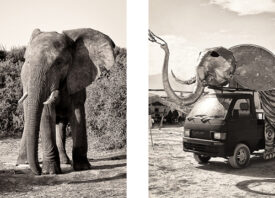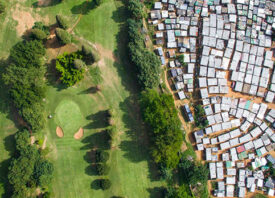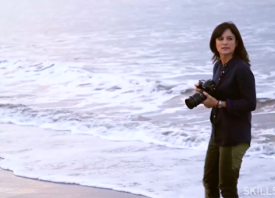Search this site
The Style and Glamour of Everyday Life in Africa


With her most recent book, entitled I love to dress like I am coming from somewhere and I have a place to go, photographer Flurina Rothenberger
has set out to highlight and embrace the contradictions, inconsistencies, and similarities inherent in any landscape as large as Africa. While this perspective is common and canonized in Western portrayals of the United States—photographers like William Eggleston and Robert Frank famously portrayed personal visions of an incredibly varied, conflicting, exciting, and banal landscape—I love to dress suggests a continued lack of global exposure to similar visions of African countries.Rothenberger’s portrayal is familiar and nuanced, stemming from the photographer’s necessarily inconsistent relationship to this location. It is both simple and complicated, intimate and outside, unknowing yet keen to the banalities that so delicately entice the well-acquainted eye. It is sweeping but not generalizing, and explicitly self-aware of its inability to be comprehensive. The book’s masterful design serves to further emphasize this point, as photographs are carefully fused into seamless diptychs, creating new compositions that refute a narrow reading of any one image. Bringing the style and glamour of everyday life to the fore, I love to dress is both a highly personal document of admiration and a carefully conceived critique of historically reductive Western depictions of life across the second largest continent in the world.
The work in I love to dress doesn’t seem to fit comfortably in any single “genre” of photography. There are certainly journalistic aspects, but at the same time the work is personal, non-linear, and resists common journalistic narratives. I’d love to hear your thoughts on the role of genre in your work, or if you think these distinctions (and the conventions that come with them) are more or less obsolete.
“What you‘ve observed gets to the heart of my intention for I love to dress like I am coming from somewhere… I didn’t want the photographs to be placed in service of one specific storyline. For my commissioned work the lead is given by a common journalistic narrative. It’s not that I don’t appreciate this genre, but I grew up in an environment where there was a deep belief and trust in the metaphorical power and the semantics of an image as such. My love for photography is rooted in that same understanding. This medium has often been instrumentalized against what I define as its actual strength: the one to elegantly suggest information and shape meaning, without implying or imposing it as the one and sole truth. The edit of I love to dress was conceived in close collaboration with the graphic design duo Hammer and intends to leave room for the photographs to unfold their own story.”

I’m curious to hear more about the decision to decontextualize these images, not providing locations, dates, etc. alongside the pictures. At first it struck me as a potential problem, like it would perpetuate over-generalized representations of Africa. But the more time I spent with the work and the book’s design, the more I saw it to have the opposite effect. In some ways it goes against the popular idea that the more specific or focused your subject matter is, the more universal or insightful the results will be. Would you agree?
“Leaving out all indications was a risky decision. I was well aware that, on a first glimpse, the missing information to the photographs’ origins could easily imply a common ignorance for the subject. It’s definitely a journalistic no-go, but that’s not where I settle this book. Hammer and I discussed it, but felt that for us it had just the opposite effect, similar to the conclusion you’ve had. Not providing written details of origin suggests an invitation to zap through bits of this vast continent in a light and joyful manner. You see active players living in a global reality, facing different opportunities and challenges. A diverse pattern of lifestyles just as you would find anywhere in the world. Africa has the unfortunate destiny of being addressed either like a delicate egg requiring extra special treatment of political correctness or like a huge lump of problems all in general. Both lack the contemporary interest for and knowledge of a highly hybridized continent. More so, these views have little in common with how people investing their lives in place would most probably describe the reality. I wanted this book to give insight not by narrowing down on one context, but by suggesting that it takes many single stories to add up to a broader perspective.”

On a related note, the sequencing and design of this book is visually stunning. Could you discuss some of your favorite design elements and how they both influenced and were influenced by your intentions going into this project? Were there themes or elements of your own photographs that were revealed to you through Hammer’s curating and design?
“It’s a correct assumption that Hammer, Sereina Rothenberger and David Schatz, had a key influence on this project. They initiated I do something with the pictures piling up in my archive. I had then reached a point with my work, where apart from handing in images I was assigned for, I had stopped editing my personal things all together. I’m driven by the people I meet, the things I observe, and all the questions these situations raise. As for the actual photograph, I often don’t know where it then fits in. I love Hammer’s work and from what I had witnessed, I knew that in order to do what they do best, they should have free rein to design and curate the book. The only condition I had was that I wanted this book to reflect what Africa is to me: a place where contrasts merge, giving up neither one nor the other. I wanted the glamour of daily life to take and keep the lead. It wouldn’t be wrong to say they then took a piece of my archive, shaved a tight selection, sequenced it, wrapped it up and handed my photographs back to me. All shiny and new.
“In the beginning I wanted to add more information in text, but as we discussed it, I came to the conclusion that this was precisely part of what had been blocking me from editing my own work: I had gotten so used to seeing my work contextualized by words, that I had lost touch and trust in resting upon the photographs to transport intention and meaning. Something I strangely enough fully did, while I was making the picture.
“Hammer had from the beginning suggested a design and structure which strongly focused on the visual. It also led to the hand-drawn design of the quotes, in reference to the framed posters you regularly see in West African homes. Commonly they feature an item of desire or aspiration completed with a written statement in the sense of willing to be blessed.
“What struck me most in the first sequencing Hammer showed me was how many familiar shots suddenly appeared in a fresh context. I hadn‘t been aware of how visible some aspects of globalization and technical advances had actually become over the span in which the photographs were taken. The Internet, cellphones, the shift from rural to urban life, all these things I had been a part of. I felt such a strong wish to remain part of all this in the time to come. The final edit was eventually just what I had hoped for. In Africa I’m often struck by the choreography of life. Shapes, colours, movement and attitudes orchestrated to create an experience both unpretentious and glamorous. It’s difficult to explain what I mean, but I recognize its reflection in the sequencing Hammer chose. I’m convinced this is because Sereina is familiar with life in place and because David has an approach to photography and design that is truly free from common constraints. And it is also the result of two parties inspired by each others’ work. It‘s what I love most about such collaborations— you can share the baby.
“My favorite design element is the actual object the book is now. One which treasures the daily events on the photographs in its very own way. It travels lightly and can easily be placed into people’s hands. Every time I see a situation, like yesterday here in Moçambique, when a group of boys clustered over the book, comfortably flipping through the pages, careless of the traces and marks they left on the paper: I know I feel truly comfortable and happy with the result.”

While it also focuses on West African communities, your previous book tackles a very different experience. I can’t help but imagine a narrative between the two works as a result from the poetically linked titles. Can you discuss I don’t know where I’m going, but I’m on the way (2004) as a precursor to I love to dress like I’m coming from somewhere and I have a place to go (2015)? Both titles seem to suggest a state of limbo…
I agree that both titles have similarities. They are both quotes, each one made by a young man from Africa figuring out the next step in life. I don‘t know where I‘m going but I‘m on the way, were the words a young refugee from Ethiopia had sketched on a small piece of paper together with a pair of sneakers. He had the drawing pinned to the wall above his bed. This was my first book and portrayed the different patterns of life amongst people from African countries living in Switzerland. I had a very specific focus and besides the photographs, the book gave room to a lot of text in which the protagonists spoke about their lives. I was studying then in 2004 and so was my sister with whom I collaborated for the first time. I don’t know where I’m going but I’m on the way reflected an inner conflict between the aspirated opportunities in a privileged country and the yearning to return home. A feeling I shared with my protagonists.
“I love to dress like I am coming from somewhere and I have a place to go is how a young Nigerian student had chosen to describe himself on the profile page of his university. I made it the title of this book because it struck me in all its accuracy. This book is focused on the daily life in different African countries. Even though it portrays people investing their life in place, a certain state of limbo flickers through. Africa has the highest concentration of young people on the planet. Their opportunities still remain limited, and ever so often it seems they are treated like an unwanted gift. Many young people I photograph are globally connected but effectively stuck. It‘s with a big effort, that they tackle obstacles eager to create a life and future for themselves. Just like a young Kenyan woman posted on her blog: Life is not about waiting for the rain to pass; it’s about learning to dance in the rain.”

You are of Swiss descent but grew up in Côte d’Ivoire, and now are living again in Switzerland. How do these various aspects of your identity both enrich and complicate your approach to photographing in and interacting with African countries?
“I can’t really say because I, like so many others, know nothing else to compare it to. There‘s been a geographical split between where I place my heart and the origin of my Western looks, long before I became a photographer. Even though I still sometimes wish I had a legitimate skin tone, foremost because I find it absolutely beautiful, it also provides a certain freedom to live different identities. In general I find it beneficial to my work as a photographer. This medium has many virtues but objectivity is certainly not one of them. Being openly tagged as a foreigner, like I commonly am in Africa, sets a kind of safety mark for me. A constant reminder that on either side of the camera, the angle of view is a personal one. I also experience that my state of being familiar with many aspects of life all the while remaining a visitor, opens doors. Even if the opposite just as well applies, I’ve witnessed many times that people confide certain issues easier to an outsider, who‘s less a threat to spread rumors.”

You’ve mentioned that a wish of yours would be to launch a platform for African photographers. Could you elaborate, and discuss some African photographers whose work and perspectives interact with and/or helped inform your own?
“An elaborate answer to this would fill a couple of pages. My love for photography was sparked by the books my father had lying around as I grew up. Formal portraits and casual shots from the work of West African photographers in the beginnings of the postcolonial period. The semantics in these photographs still move me like no other. The skillful buildup of complex meaning and relationships is of a kind, which to me defines the very heart of photography. I often think about how so many recent photographers I discover from Africa succeed in this very same tradition. Creating images which seem to reinvent what is right in front of them every day. A feel for what life is actually about. Who you are to others, what they are to you and how both aspects shape where each one is headed.
“As for African photographers whose work has recently interacted with my own. There is Cheikh Diallo, a photographer I met while working in Dakar, on a project about urbanization in clash with climate change. He deals with the same topic in his work and we clicked instantly. So we ended up collaborating and exhibiting the subject together. An exchange which was one of my best. Aboubacar Traoré and Fatoumata Traoré are two young inspiring photographers from Mali I was recently introduced to in Bamako. Fatoumata has been permanently documenting the increasing modernization of her natal village, an effect she observed and was created also by students such as herself, plying between the countryside and the city. Aboubacar addresses the visual signs of migration between the Ivorian and Malian border with a very individual style and creativity. I enjoy my daily consumption of Francis Kokoroko‘s street photography from Accra and I love keeping up to date with Everyday Africa. I too closely follow Baudoin Mouanda‘s work. He’s simply brilliant and has a strong interest for the young generation, which I can totally connect with. He‘s also engaged in Génération Elli, a collective of photographers in Brazzaville. I can‘t close this very small version of my list without mentioning Zanele Muholi, whom I admire for her creativity, drive and courage. Her self-portraits are one of a kind, I can dig in and reflect on.”

All images © Flurina Rothenberger



